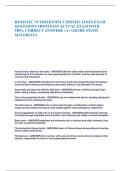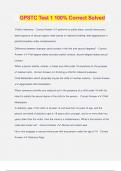HOLISTIC NUTRITIONIST CERTIFICATION EXAM
QUESTIONS FROM PAST ACTUAL EXAM WITH
100% CORRECT ANSWERS | A+ GRADE STUDY
MATERIALS
Human basic needs for the body - ANSWERSufficient clean water and wholesome food
containing all the nutrients we need, good quality air to breath, and the right amount of
exercise and movement.
In one hour - ANSWERAll the blood in the human body has passed through the kidneys
once and been filtered,controlling not only water balance, but elimination of toxins.
Some daily practices for Holistic Self-Care - ANSWERexercise, drinking enough clean
water, eating simply, and paying attention to breathing.
One of the properties of skin - ANSWERto act as a waterproof barrier, keeping dangerous
substances from entering the body.
The skin acts as - ANSWERa line of immunity through a combination of both watery
sweat and oily sebum,forming an acid mantle against many pathogenic organisms.
Some suggestions to take care of our bones include - ANSWERweight bearing exercise,
including enough vegetable source protein, and reducing salt intake, as some examples.
Bone tonic - ANSWERDandelions are extremely rich in calcium and other minerals; they
are also a powerful detoxifier.
The connective tissue fascia - ANSWERa layer of fibrous tissue surrounding all muscles,
blood vessels and nerves.
The fascia is - ANSWERrich in nerves, with up to ten times more sensory receptors than
muscle, responsible for most of our proprioceptive sense.
,The heart - ANSWERhas an internal pacemaker, keeping the heart beating without
outside stimulation. The heart rate can change from moment to moment in response to
information received from hormones and nerve impulses.
Homocysteine - ANSWERNormal byproduct of cell metabolism, but if too much
accumulates, it can be damaging and lead to higher risks of heart disease and brain
disorder.
Lymphatic capillaries - ANSWERAllow large amounts of tissue fluid containing debris too
big to enter blood capillaries, including proteins, pus, damaged or dead cells, bacteria,
and other pathogens and cancerous cells.
Holistic self-care includes - ANSWERadequate hydration, reducing saturated fats in the
diet, walking more, and improving breathing.
The immune system - ANSWEROperates both the lymphatic and circulatory systems and
consists of both simple non-specific and specific immunity.
Fever and mucus production - ANSWERImportant first lines of immunity defense.
Humans are designed to breathe - ANSWERThrough the nose when possible, which
filters the air on the way into the lungs
Air is moved in and out of the lungs - ANSWERby the action of the diaphragm and
intercommunicates, which contract and make the chest cavity bigger.
Increasing negative ions in the home - ANSWEROpening doors and windows regularly,
using certain essentials oils, and have certain houseplants
A leaky gut - ANSWERCan occur as a result of an inflammatory response from a food
that has caused anintolerance or allergic reaction, thereby interfering with normal
digestion.
Sugars broken down from carbohydrates - ANSWERwe eat are used to make DNA,
critical in cell replication.
The liver's main functions - ANSWERMaking bile, aiding in digestion, vitamin
storage,metabolizing protein, sorting out fats, heat production and detoxification.
Signs and symptoms of a non-functioning liver - ANSWERNausea, heartburn,
constipation, and chronic fatigue, to name a few
Each hour, the kidneys... - ANSWERfilter all the blood in the human body through a
series of nephrons that number around a half-million.
Yellow or dark urine - ANSWERSigns of acute dehydration, and can include feeling tired
and fatigued, dry mouth, headaches, and dizziness.
There are at least 100 different peptides - ANSWERknown to act as neurotransmitters,
including serotonin and dopamine, to name a few
, The conscious part of the nervous system is - ANSWERReferred to as the somatic
nervous system, and the area that deals with unconscious activities is referred to as the
autonomic nervous system.
The thyroid gland - ANSWERIncreases metabolism through the release of thyroid
hormones T3 and T4; it also promotes protein synthesis, the carbohydrate absorption
rate in the gut, and update of glucose by cells and fat metabolism.
One way to protect the pancreas is to - ANSWERAvoid all processed foods while
including essential nutrients each day, including omega-3 fatty acids.
Estrogen - ANSWERNot only makes eggs, it governs what are referred to as secondary
sexual characteristics: soft skin and hair, breast development and fat distribution
Protecting the prostate includes - ANSWERavoiding smoking, maintaining a healthy
weight, including good sources of zinc in the diet, and avoiding sitting all day.
Only _____ of medical schools in the United States appear to offer a single dedicated
course on nutrition. - ANSWERa quarter
Most deaths in the United States - ANSWERAre preventable, and they are related to what
we eat, with diet being the number one cause of premature death and the number cause
of disability
Researchers have noted that average younger Americans, 20 years old in 2006, are living
- ANSWERtwo fewer functional years then a 20-year-old from the year 1990
The average American obtains ____ percent of daily caloric intake from animal products
and _____ percent of their calories from processed plant foods. - ANSWER32;57
The optimal LDL cholesterol level to minimize the risks of cardiovascular disease is -
ANSWERbetween 80 and 100 mg/dl
Statin drugs to lower cholesterol - ANSWERfound to not be completely safe, with
damage reported to the liver or the kidneys
Lung cancer is - ANSWERThe number one cancer killer in the United States, with more
than 160,000 thousand deaths each year directly related to smoking.
Eighty-five percent of women die - ANSWERWithin five years of lung cancer diagnosis,
with 90 percent of deaths due to the spread of the cancer to other parts of the body.
The number of particles deposited into the lungs - ANSWERIncreases by a factor of ten
when frying indoors versus frying outdoors.
A low fiber intake is - ANSWERAssociated with a stiffening of the arteries leading up to
the brain, which is a key risk factor for stroke.
Antioxidant-rich diets - ANSWERAppear to protect against stroke by preventing the
circulation of oxidized fats in the bloodstream that can damage the sensitive walls of
small blood vessels in the brain





